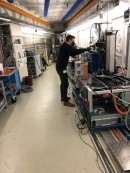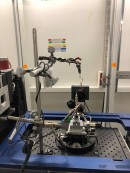We’re so used to having advanced technology in our daily lives we don’t even question how it works. Take lithium metal batteries, for instance. Compared to lithium-ion batteries, they cannot be recharged, but they provide the highest possible energy density. Nobody had seen how they work, to actually observe them in action. That was until recently. A group of researchers succeeded in seeing how the lithium metal in the cell behaves as it charges and discharges.
The battery researchers from the Chalmers University of Technology in Sweden have created real-time 3D images of lithium metal battery as it cycles. The discovery is indeed facinating to look at. But it can open the door to new opportunities in this field. The target is to understand the exact mechanism and phenomena of battery cycling. This is how we might be able to create batteries with higher capacity and ensure safer use in our future devices, EVs, and more.
It’s clear that lithium-ion batteries are the norm nowadays. But they're limited in what they can do. So people are exploring other concepts that could replace them. And lithium metal batteries are one of them. Several factors are taken into consideration: cost (both environmental and financial), energy density, and safety. Other promising alternatives are solid-state batteries, lithium-sulfur batteries, and lithium-oxygen batteries.
All these concepts are built around the same idea that the battery anode will consist of lithium metal instead of graphite, which is used in today’s batteries. The battery cell with lithium metal as an anode will weigh less, enabling the use of high-capacity cathode materials. This leads to the possibility of achieving three to five times the energy density.
Of course, lithium metal batteries aren’t a miracle solution – they have one crucial issue: when charged or discharged, the lithium doesn’t always deposit as it should, flat and smooth. It often forms mossy microstructures or dendrites, which are long needle-like structures. That’s how parts of the deposited lithium can become isolated and then inactive. If dendrites reach the other battery electrode, a short circuit can happen. That’s why it’s essential to gain insights into how, when, and why these structures form.
Chalmers researched Matthey Sadd, the head author of this new study, said, “To be able to use this technology in the next generation of batteries, we need to see how a cell is affected by factors such as current density, the choice of electrolyte and the number of cycles. Now we have a tool to do so.”
So, how did the researchers get the first glimpse into the battery cell? At the Swiss Light Source outside Zurich, Switzerland, the team prepared a specially designed battery cell and observed its inner workings in real-time and in 3D via X-ray tomographic microscopy. According to the team, no one had been able to do so until now, at least to their knowledge.
Aleksandar Matic, professor at the Department of Physics at Chalmers, described seeing the inner working for the first time as a magical moment. Especially since it happened on the first attempt. He even compared it to being in a lunar landing project. You can imagine the importance of this discovery for the future of batteries, so of course, the team was excited, given that they had been working on this achievement for a long time.
“What’s next?”, you might be wondering. The research team aims to test the technique on other battery concepts, such as the ones I mentioned above. Moreover, it hopes that the necessary imaging technology will be available closer to their home, for instance, at the Swedish MAX IV lab, a national research facility for advanced x-ray experiments.
There is more to be explored with this method, and its development has enormous potential. For example, Matic declared the researchers are looking forward to refining the technique for faster measurements at higher resolution. This way, the team can see more detailed microstructures formed early in the deposition process.
He describes this advancement as the next key piece of the puzzle of safely using lithium metal batteries on a large scale. This is especially important as many research teams and companies are considering the lithium metal concept for future prototypes.
Researchers estimate that the breakthrough for the next generation of batteries is around ten years away. Technology is evolving fast. It wouldn’t come as a surprise if it happened even quicker than that. Regardless, as the world slowly becomes more electrified, these technological advances will play a critical role.
It’s clear that lithium-ion batteries are the norm nowadays. But they're limited in what they can do. So people are exploring other concepts that could replace them. And lithium metal batteries are one of them. Several factors are taken into consideration: cost (both environmental and financial), energy density, and safety. Other promising alternatives are solid-state batteries, lithium-sulfur batteries, and lithium-oxygen batteries.
All these concepts are built around the same idea that the battery anode will consist of lithium metal instead of graphite, which is used in today’s batteries. The battery cell with lithium metal as an anode will weigh less, enabling the use of high-capacity cathode materials. This leads to the possibility of achieving three to five times the energy density.
Of course, lithium metal batteries aren’t a miracle solution – they have one crucial issue: when charged or discharged, the lithium doesn’t always deposit as it should, flat and smooth. It often forms mossy microstructures or dendrites, which are long needle-like structures. That’s how parts of the deposited lithium can become isolated and then inactive. If dendrites reach the other battery electrode, a short circuit can happen. That’s why it’s essential to gain insights into how, when, and why these structures form.
Chalmers researched Matthey Sadd, the head author of this new study, said, “To be able to use this technology in the next generation of batteries, we need to see how a cell is affected by factors such as current density, the choice of electrolyte and the number of cycles. Now we have a tool to do so.”
Aleksandar Matic, professor at the Department of Physics at Chalmers, described seeing the inner working for the first time as a magical moment. Especially since it happened on the first attempt. He even compared it to being in a lunar landing project. You can imagine the importance of this discovery for the future of batteries, so of course, the team was excited, given that they had been working on this achievement for a long time.
“What’s next?”, you might be wondering. The research team aims to test the technique on other battery concepts, such as the ones I mentioned above. Moreover, it hopes that the necessary imaging technology will be available closer to their home, for instance, at the Swedish MAX IV lab, a national research facility for advanced x-ray experiments.
There is more to be explored with this method, and its development has enormous potential. For example, Matic declared the researchers are looking forward to refining the technique for faster measurements at higher resolution. This way, the team can see more detailed microstructures formed early in the deposition process.
He describes this advancement as the next key piece of the puzzle of safely using lithium metal batteries on a large scale. This is especially important as many research teams and companies are considering the lithium metal concept for future prototypes.
Researchers estimate that the breakthrough for the next generation of batteries is around ten years away. Technology is evolving fast. It wouldn’t come as a surprise if it happened even quicker than that. Regardless, as the world slowly becomes more electrified, these technological advances will play a critical role.







